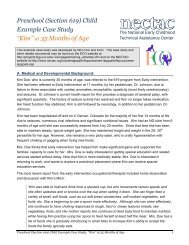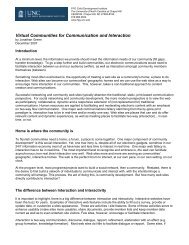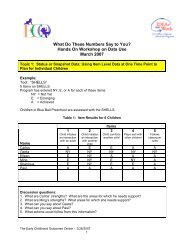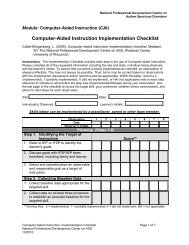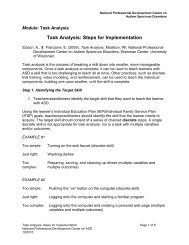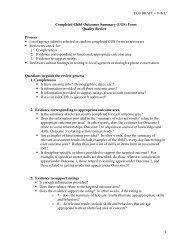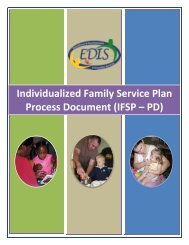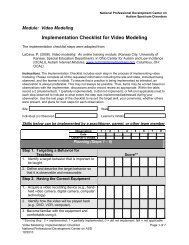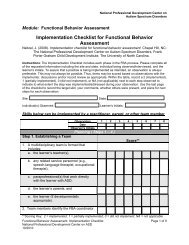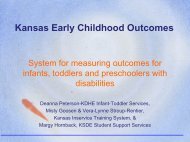Steps for Implementation: Response Interruption/Redirection
Steps for Implementation: Response Interruption/Redirection
Steps for Implementation: Response Interruption/Redirection
- No tags were found...
Create successful ePaper yourself
Turn your PDF publications into a flip-book with our unique Google optimized e-Paper software.
National Professional Development Center onAutism Spectrum DisordersModule: <strong>Response</strong> <strong>Interruption</strong>/<strong>Redirection</strong> (RIR)<strong>Steps</strong> <strong>for</strong> <strong>Implementation</strong>: <strong>Response</strong> <strong>Interruption</strong>/<strong>Redirection</strong>Neitzel, J. (2009). <strong>Steps</strong> <strong>for</strong> implementation: <strong>Response</strong> interruption/redirection. Chapel Hill, NC:The National Professional Development Center on Autism Spectrum Disorders, FrankPorter Graham Child Development Institute, The University of North Carolina.<strong>Response</strong> interruption/redirection (RIR) is an evidence-based practice used to decreaseinterfering behaviors, predominantly those that are repetitive, stereotypical, and self-injurious innature. RIR is particularly useful with persistent interfering behaviors that occur in the absenceof other people, in a number of different settings, and during a variety of tasks. These behaviorsoften are not maintained by attention or escape. Rather, they are more likely to be maintainedby sensory rein<strong>for</strong>cement and are often resistant to intervention attempts (Fellner, Laroche, &Sulzer-Azaroff, 1984). RIR is particularly effective with sensory-maintained behaviors becauseteachers/practitioners interrupt learners from engaging in interfering behaviors and redirect themto more appropriate, alternative behaviors.RIR contains two main components: (1) response interruption and (2) redirection. During theresponse interruption component of the intervention, teachers/practitioners stop the learner fromengaging in the interfering behavior. This is usually accomplished by physically and/or verballyblocking a learner’s attempts to engage in a stereotypical or repetitive behavior (e.g., teacherputs her hand at a short distance from the learner’s mouth when he tries to engage in handmouthing). <strong>Redirection</strong>, the second component of the intervention, focuses on prompting thelearner to engage in a more appropriate, alternative behavior. Both of these components will bedescribed further in this document along with the additional steps needed to use RIR effectively.Step 1. Identifying the Interfering BehaviorIn Step 1, teachers/practitioners identify an interfering behavior <strong>for</strong> a learner with ASD that theywould like to decrease. In most cases, the interfering behavior is one that is interfering withlearning and development (i.e., vocal stereotypy, pica, hand mouthing). There<strong>for</strong>e,teachers/practitioners complete a high quality functional behavioral assessment (FBA) toidentify the function of the interfering behavior and select an appropriate replacement behaviorthat can be taught as part of the redirection component of the intervention. Please refer toFunctional Behavioral Assessment: <strong>Steps</strong> <strong>for</strong> <strong>Implementation</strong> (National ProfessionalDevelopment Center on ASD, 2008) to acquire more in-depth in<strong>for</strong>mation about thefollowing FBA strategies.1. Teachers/practitioners identify the characteristics of the interfering behavior by usingdirect observation methods that generally include:a. A-B-C data charts. A-B-C data charts help team members determine what happensright be<strong>for</strong>e the behavior (the antecedent), the behavior that occurs, and whathappens directly after the behavior (the consequence). These data provide insightinto why the learner may be engaging in a particular behavior.b. scatterplots. Scatterplots help team members determine:<strong>Response</strong> <strong>Interruption</strong>/<strong>Redirection</strong>: <strong>Steps</strong> <strong>for</strong> <strong>Implementation</strong> Page 1 of 8National Professional Development Center on ASD10/2010
National Professional Development Center onAutism Spectrum DisordersModule: <strong>Response</strong> <strong>Interruption</strong>/<strong>Redirection</strong> (RIR)the possible functions of the behavior,when the behavior is occurring, andtimes of the day when an intervention might be implemented to reduce theinterfering behavior.2. Teachers/practitioners use direct assessment results to identify:a. where the behavior is happening;b. with whom the behavior is occurring;c. when the behavior is happening;d. activities during which the behavior occurs;e. what other students are doing when the behavior starts;f. what teachers/adults are doing when the behavior starts;g. proximity of other students, teachers, and/or adults;h. the noise level in the environment;i. the number of individuals in the area;j. other environmental conditions (e.g., lighting, door open/closed); andk. the function of the behavior (i.e., to get or obtain something--obtaining internalstimulation, wanting something because it feels good, obtaining attention, obtainingactivities or objects; or to escape or avoid--obtaining internal stimulation, not wantingsomething because it feels bad, escaping or avoiding attention, avoiding tasks oractivities).3. Teachers/practitioners develop a hypothesis statement <strong>for</strong> the interfering behavior thatincludes:a. the setting events (i.e., the environment or conditions in which the behavior occurs),immediate antecedents, and immediate consequences that surround the interferingbehavior;b. a restatement and refinement of the description of the interfering behavior that isoccurring; andc. the function the behavior serves (i.e., get/obtain, escape/avoid).EXAMPLE: Michael repeats what is said to him and uses repetitive language to avoid beingasked questions to which he does not know the answer.EXAMPLE: Jenna wanders around in the dramatic play area during free play, picks dirt off thefloor, and ingests it.4. Teachers/practitioners identify a more appropriate, alternative behavior to take the placeof the interfering behavior.When identifying an alternative behavior, especially those that are maintained by sensoryrein<strong>for</strong>cement, it is important to identify a behavior that provides the same sensoryrein<strong>for</strong>cement to the learner with ASD, but in a more appropriate way. The following table<strong>Response</strong> <strong>Interruption</strong>/<strong>Redirection</strong>: <strong>Steps</strong> <strong>for</strong> <strong>Implementation</strong> Page 2 of 8National Professional Development Center on ASD10/2010
National Professional Development Center onAutism Spectrum DisordersModule: <strong>Response</strong> <strong>Interruption</strong>/<strong>Redirection</strong> (RIR)Table 3. Example Interval Data Collection SheetDate Hand flapping (every 30 seconds) Total Be<strong>for</strong>e,1 2 3 4 5 6 7 8 9 10 11 12 13 14 15 during, orafter RIR7/27/08 x x x x x x x x 8 Be<strong>for</strong>e7/28/08 x x x x x x x x x x x 11 Be<strong>for</strong>e7/29/08 x x x x x x x x x x x 11 Be<strong>for</strong>e7/30/08 x x x x x x x 7 During7/31/08 x x x x x 5 During8/01/08 x x x 3 Duringc. Duration data. Duration data are used to determine how long a learner engages in aparticular behavior during a class, activity, or treatment session. For example, ateacher might collect data on how long a learner with ASD engages in handmouthing during math class. Table 4 provides an example of a duration datacollection sheet. A blank data sheet can be found in the Resources section of themodule.Table 4. Example Duration Data Collection Sheet <strong>for</strong> Hand MouthingDate Activity Start time End Time TotalminutesBe<strong>for</strong>e, during, orafter RIR7/26/08 English 9:00 9:15 15 Be<strong>for</strong>e7/27/08 English 9:05 9:20 15 Be<strong>for</strong>e7/28/08 Math 10:00 9:10 10 Be<strong>for</strong>e7/29/08 Resource 11:15 11:27 12 Be<strong>for</strong>e7/30/08 English 9:10 9:14 4 During7/31/08 Math 10:15 10:20 5 During8/01/08 Resource 11:05 11:10 5 DuringBaseline data give teachers/practitioners a starting point from which they can evaluate whetherthe interfering behavior decreases as a result of RIR.2. Teachers/practitioners collect baseline data <strong>for</strong> a minimum of four days be<strong>for</strong>eimplementing RIR.3. Teachers/practitioners collect baseline data in numerous settings and/or activities <strong>for</strong>four days in each setting/activity.It often is useful to have more than one practitioner collect baseline data over the course ofseveral days to compare findings. Also, by collecting data in multiple settings, teachers/practitioners can potentially recognize patterns of behavior. For example, does the learnerengage in the interfering behavior more often in one setting than another? This kind of<strong>Response</strong> <strong>Interruption</strong>/<strong>Redirection</strong>: <strong>Steps</strong> <strong>for</strong> <strong>Implementation</strong> Page 5 of 8National Professional Development Center on ASD10/2010
National Professional Development Center onAutism Spectrum DisordersModule: <strong>Response</strong> <strong>Interruption</strong>/<strong>Redirection</strong> (RIR)in<strong>for</strong>mation helps teachers/practitioners identify activities or settings where RIR can be used todecrease the interfering behavior.Step 3. Implementing RIRIn Step 3, teachers/practitioners implement the response interruption and redirectioncomponents of the intervention.1. Teachers/practitioners praise learner’s independent use of appropriate skills.EXAMPLE: A learner with ASD who engages in frequent hand flapping during small groupactivities is observed putting his hands together rather than engaging in the interfering behavior.The learner’s teacher gives him a sticker each time he uses the alternative behavior rather thanflapping his hands during the activity.2. When a learner begins to exhibit an interfering behavior, teachers/practitioners interruptthe learner’s attempts by using:a. physical blocking. With this approach, teachers/practitioners physically prevent thelearner from engaging in a motor stereotypy. Teachers/practitioners should use theleast amount of physical assistance necessary to stop the learner from engaging inthe interfering behavior. Often, only one to two seconds of physical contact is neededto stop a learner from using the behavior.EXAMPLE: A teacher places her hand about an inch from a learner’s mouth when he attemptsto put his hand in his mouthEXAMPLE: A teacher puts his hand on a learner’s when she begins flapping her hands.b. verbal blocking. With this approach, teachers/practitioners prevent the learner fromengaging in the interfering behavior by issuing a verbal directive.EXAMPLE: A teacher says “No, don’t” when a learner attempts to put her hand in her mouth.3. For learners who engage in vocal stereotypies, teachers/practitioners redirect learners touse an identified alternative behavior by:a. saying the learner’s name in a neutral tone of voice,b. establishing eye contact with the learner, andc. asking a social question to prompt the learner to use an alternative vocalization.EXAMPLE: A learner begins squealing during one-to-one work time. The teacher asks thelearner, “Where do you live?” or “What color is your shirt?”4. For learners who engage in motor stereotypies or self-injurious behaviors,teachers/practitioners redirect them to engage in an identified alternative behavior by:<strong>Response</strong> <strong>Interruption</strong>/<strong>Redirection</strong>: <strong>Steps</strong> <strong>for</strong> <strong>Implementation</strong> Page 6 of 8National Professional Development Center on ASD10/2010
National Professional Development Center onAutism Spectrum DisordersModule: <strong>Response</strong> <strong>Interruption</strong>/<strong>Redirection</strong> (RIR)a. saying the learner’s name in a neutral tone of voice,b. establishing eye contact with the learner, andc. using the system of least-to-most prompts to help the learner engage in thealternative behavior.With this strategy, teachers/practitioners gradually provide increasing assistance to help alearner use an alternative behavior. The most intrusive level of prompt ensures that learnerswith ASD use the target skill successfully. Please refer to Least-to-Most Prompting: <strong>Steps</strong><strong>for</strong> <strong>Implementation</strong> (National Professional Development Center on ASD, 2008) <strong>for</strong> morein<strong>for</strong>mation about least-to-most prompting.5. For learners who engage in pica (i.e., eating non-edible items), teachers/practitionersredirect them to engage in an identified alternative behavior by:a. making a preferred food item (e.g., popcorn, goldfish crackers) freely available duringtimes when pica is most prevalent,b. saying the learner’s name in a neutral tone of voice,c. establishing eye contact with the learner, andd. using the system of least-to-most prompts to help the learner engage in thealternative behavior.EXAMPLE: A teacher places a bowl of goldfish crackers on a table in the dramatic play areaduring free play. When the learner with ASD attempts to pick up a piece of dirt off the floor andput it in her mouth, the teacher, says, “Molly, don’t,” and puts her hand in front of the learner’smouth to stop her from ingesting it. The teacher waits until eye contact has been establishedand then points to the bowl of goldfish on the table. When the learner with ASD tries to pick upanother piece of dirt and put it in her mouth, the teacher gently guides her to the table and says,“Goldfish.”6. After redirecting the learner to the alternative behavior, teachers/practitioners require thelearner to engage in the alternative behavior <strong>for</strong> a specified period of time.Teachers/practitioners initially require the learner to use the alternative behavior <strong>for</strong> a minimalamount of time (e.g., 2 to 3 seconds). As learners begin to use the alternative behavior moreoften than the interfering behavior, teachers/practitioners increase the amount of time requiredof the learner to engage in the alternative behavior (e.g., 2 minutes, 10 minutes) be<strong>for</strong>eproviding rein<strong>for</strong>cement.7. Teachers/practitioners rein<strong>for</strong>ce the learner’s use of the alternative behavior.Teachers/practitioners immediately provide rein<strong>for</strong>cement after the learner with ASD engagesin the alternative behavior <strong>for</strong> the specified amount of time. The goal of rein<strong>for</strong>cement is toincrease the likelihood that the learner with ASD will use the target skill again in the future.There<strong>for</strong>e, selected rein<strong>for</strong>cers should be highly motivating to the learner with ASD. Aslearners begin to use the alternative behavior independently, rein<strong>for</strong>cement is gradually faded to<strong>Response</strong> <strong>Interruption</strong>/<strong>Redirection</strong>: <strong>Steps</strong> <strong>for</strong> <strong>Implementation</strong> Page 7 of 8National Professional Development Center on ASD10/2010
National Professional Development Center onAutism Spectrum DisordersModule: <strong>Response</strong> <strong>Interruption</strong>/<strong>Redirection</strong> (RIR)allow <strong>for</strong> generalization and maintenance. Please refer to Positive rein<strong>for</strong>cement: <strong>Steps</strong> <strong>for</strong><strong>Implementation</strong> (National Professional Development Center on ASD, 2008) <strong>for</strong> morein<strong>for</strong>mation about rein<strong>for</strong>cement.Step 4. Monitoring Learner Progress1. Teachers/practitioners use progress monitoring data to evaluate whether the interferingbehavior is decreasing as result of the intervention.2. Teachers/practitioners use progress monitoring data to evaluate the learner’s use of thealternative behavior in settings/activities where the interfering behavior typically occurs.The same data collection sheets that were used to collect baseline data can be used to tracklearner progress.3. Teachers/practitioners use progress monitoring data to adjust intervention strategies ifthe interfering behavior is not decreasing.If the interfering behavior is not decreasing, teachers/practitioners must identify potentialreasons <strong>for</strong> this. The following questions may be helpful during this problem-solving process.Is the interfering behavior well defined? That is, is it observable and measurable?Is RIR being implemented consistently by all staff?Does the alternative behavior provide the same sensory rein<strong>for</strong>cement as theinterfering behavior?ReferencesFellner, D.J., Laroche, M., & Sulzer-Azaroff, B. (1984). The effects of adding interruption todifferential rein<strong>for</strong>cement on targeted and novel self-stimulatory behaviors. Journal ofBehavior, Therapy, and Experimental Psychiatry, 15(4), 315-321.<strong>Response</strong> <strong>Interruption</strong>/<strong>Redirection</strong>: <strong>Steps</strong> <strong>for</strong> <strong>Implementation</strong> Page 8 of 8National Professional Development Center on ASD10/2010



